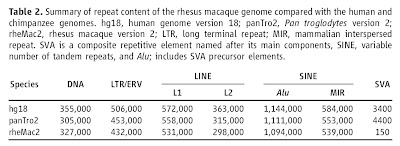The April 13 issue of Science includes a collection of papers reporting and analyzing the sequence of the macaque (Macaca mulatta) genome. This marks the third primate genome to be sequenced (after human in 2001 and chimpanzee in 2005). Needless to say, comparisons of three genomes are far more informative than analyses involving only one or two sequences, and the papers contained in the special issue of Science already include some novel insights of evolutionary and medical significance that were previously unattainable. Carl Zimmer at The Loom provides a general summary of some key findings.
There is, rightly, a lot of interest in comparing genes among the three primate species. Non-coding DNA also gets a much-deserved amount of attention; in fact, this time we are fortunate enough to see an entire paper devoted to transposable elements. One general finding of interest relates to the number of transposable elements in the three genomes, which is remarkably similar (and quite high) in the three species. Here is the breakdown:

No wonder Ford Doolittle once remarked, probably only half-jokingly, that “our genomes … might be ironically viewed as vehicles for the replication of Alu sequencesâ€. They do, after all, outnumber protein-coding genes by about 50 : 1.
The Genomes OnLine Database (GOLD) provides a list of other completed and forthcoming genome sequences. The macaque is only the latest in a rapidly growing list of genome projects that will continue to provide exciting new information about the evolution of genomes and the organisms carrying them.
